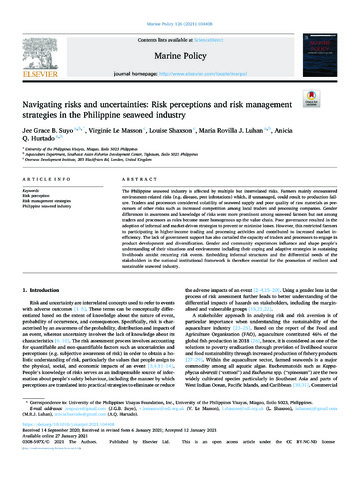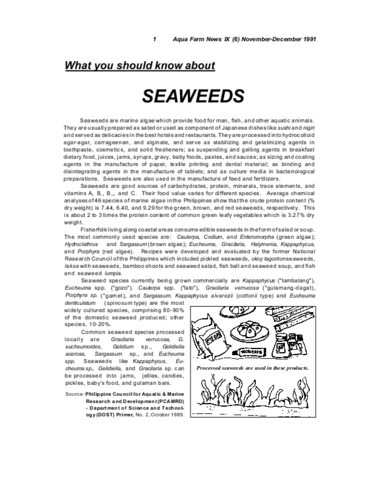Achieving high production of micropropagated seaweed through optimization of the culture protocol
- Global styles
- MLA
- Vancouver
- Elsevier - Harvard
- APA
- Help
Date
2023-07Page views
993ASFA keyword
AGROVOC keyword
Taxonomic term
Metadata
Show full item record
Share
Abstract
Kappaphycus and Eucheuma are the two carrageenanproducing red algae extensively cultured and farmed in tropical and subtropical waters. Seaweed production accounted for 5.4 percent of the world’s aquaculture production in 2019, which was over USD 15 billion in value. With this value share, the production of seaweed farming was higher than other aquatic commodities, such as tilapia, carp, shrimps, and others (Cai et al., 2021). The red algae production of the Philippines started in the 1960s (Ronquillo & Gabral-Llana, 1989), and by the early 2000s, the country had become the world’s top supplier of seaweed, particularly Kappaphycus sp., until 2007, when Indonesia outperformed it.
Problems and challenges in seaweed farming, including climate change, pests and diseases, and biosecurity issues, caused the continuous decline of the seaweed production yield (Faisan, Sollesta-Pitogo, & de la Peña, 2022). Furthermore, the deterioration of seaweed quality caused by the repetitive use of vegetative cutting methods has also become one of the most pressing concerns in seaweed farming. Unfortunately, this procedure of growing plantlets for farming is one of the most common methods many seaweed farms used in the Philippines and other countries.
Research in SEAFDEC Aquaculture Department (AQD) looks into breaking from the conventional method of farming seaweed plantlets and optimizing laboratorybased production. With this, it hopes to create a more sustainable source of propagules, better growth and survival in grow-out, and a higher carrageenan quality in cultured Kappaphycus alvarezii.
Suggested Citation
Sollesta-Pitogo, H., Faisan, J. P., Jr., & de la Cruz-Aranas, J. M. V. (2023). Achieving high production of micropropagated seaweed through optimization of the culture protocol. Fish for the People , 21(1), 12-15. http://hdl.handle.net/20.500.12066/7355
Type
magazineArticleCollections
- Fish for the People [41]
Related items
Showing items related by title, author, creator and subject.
-
Navigating risks and uncertainties: Risk perceptions and risk management strategies in the Philippine seaweed industry
Suyo, Jee Grace; Le Masson, Virginie; Shaxson, Louise; Luhan, Maria Rovilla; Hurtado, Anicia Q. (Elsevier, 2021-04)The Philippine seaweed industry is affected by multiple but interrelated risks. Farmers mainly encountered environment-related risks (e.g. disease, pest infestations) which, if unmanaged, could result to production failure. ... -
Status of seaweed farming in Region 9
Kalbi, Halpi H. (Aquaculture Department, Southeast Asian Fisheries Development Center, 2002) -
What you should know about seaweeds
Carreon-Lagoc, Julia; Southeast Asian Fisheries Development Center, Aquaculture Department (Aquaculture Department, Southeast Asian Fisheries Development Center, 1991)








